Digital Camera Home >
Travel Zoom Shootout 2011
Travel Zoom Shootout 2011: Intro, Design and Handling
Six pocket long zoom digital cameras compared
by Shawn Barnett with Dave Etchells and Rob Murray
Posted: 12/19/2011
Introduction
Smartphones have punched a hole in many product categories, not the least of which is the simple pocket digital camera. Still, one category of pocket digital camera that's not withered is the pocket long zoom, or travel zoom, and and quite a few players have joined the category in the last few years. As ubiquitous as they are, smartphone cameras can't pretend to zoom to even 3x optically, let alone compete with the 12-18x optical zooms we've gathered for our Travel-Zoom Shootout. Whether on a short trip or long vacation, a pocket long zoom can handle nearly all types of family and tourist photography, bringing in far objects with a quick flick of the zoom ring. And recent offerings also start out quite a bit wider than models past, ranging from 24 to 28 at their widest.
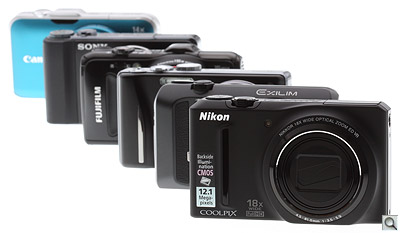 Four out of six of our challengers we've already reviewed, and those four were also chosen as Dave's Picks in 2011. But now we've started over and are giving them a fresh look against two other pocket long zooms we've added to the mix. Our contenders are: the Nikon S9100, Panasonic ZS8, Casio ZR100, Canon SX230, Sony HX9V, and Fujifilm F550.
Four out of six of our challengers we've already reviewed, and those four were also chosen as Dave's Picks in 2011. But now we've started over and are giving them a fresh look against two other pocket long zooms we've added to the mix. Our contenders are: the Nikon S9100, Panasonic ZS8, Casio ZR100, Canon SX230, Sony HX9V, and Fujifilm F550.
We'll compare them in several categories, and talk about how they were to use in each area. In the end, we're sure to come up with a few winners, in addition to one overall preferred camera, but you may learn that another camera fits your needs just fine based on what we've uncovered.
As for their order of appearance in the shootout, this is based not on the Alphabet, but on our overall opinion of them from an operational standpoint, not including image quality or other performance issues. The first three are the ones we liked most in terms of handling; in order of preference, those are the Nikon S9100, Panasonic ZS8, and Casio ZR-100.
Our goal with this Shootout is not to be exhaustive, but to convey a simple set of information about a selection of cameras that are quite a bit more complex than we'll be covering here. Let us know what you think of our Shootout format as it is, and what you'd like to see in future reviews like this.
The Contenders
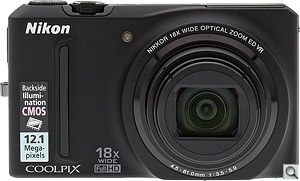 |
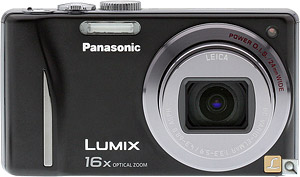 |
Nikon Coolpix S9100
- 12.1MP CMOS, 1/2.3
- 18x zoom 25-450mm
- 3-inch, 922K-dot LCD
- ISO Auto, 160-3,200
- Full HD video (1080p30)
- mini-HDMI out
- Hybrid VR image stabilization
- Easy Panorama
- Handheld night modes
- Best Shot Selector
- RAW mode not supported
- Price: ~$280 ($330 MSRP)
|
Panasonic Lumix ZS8
- 14.1MP CCD, 1/2.3
- 16x zoom, 24-384mm
- 3-inch, 230K-dot LCD
- ISO Auto, 100-1,600
- HD video (720p30)
- A/V out (no HDMI)
- Power O.I.S. image stabilization
- Intelligent auto
- Intelligent zoom
- Intelligent exposure
- RAW mode not supported
- Price: ~$250 ($280 MSRP)
|
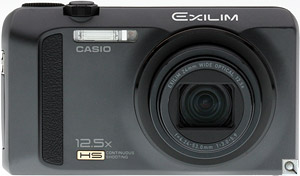 |
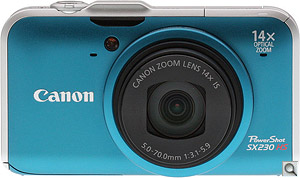 |
Casio Exilim ZR100
- 12.1MP CMOS, 1/2.3
- 12.5x zoom, 24-300mm
- 3-inch, 461K-dot LCD
- ISO Auto, 100-3,200
- Full HD video (1080p30)
- mini-HDMI out
- Sensor-shift image stabilization
- HDR modes
- Slide Panorama
- 40 fps High speed burst
- RAW mode not supported
- Price: ~$290 ($300 MSRP)
|
Canon PowerShot SX230 HS
- 12.1MP HS CMOS, 1/2.3
- 14x zoom, 28-392mm
- 3-inch, 461K-dot LCD
- ISO Auto, 100-3,200
- Full HD video (1080p24)
- mini-HDMI out
- Optical image stabilization
- 8.1 fps High speed burst
- Handheld Night Scene
- GPS
- RAW mode not supported
- Price: ~$250 ($350 MSRP)
|
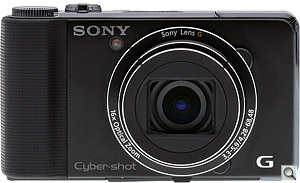 |
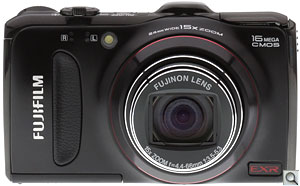 |
Sony CyberShot HX9V
- 16.2MP CMOS, 1/2.3
- 16x zoom, 24-384mm
- 3-inch, 922K-dot LCD
- ISO Auto, 100-3,200
- Full HD video (1080p60)
- mini-HDMI out
- Optical SteadyShot image stabilization
- 3D modes
- iSweep Panorama
- GPS
- RAW mode not supported
- Price: ~$330 ($350 MSRP)
|
Fujifilm FinePix F550EXR
- 16MP CMOS, 1/2
- 15x zoom, 24-360mm
- 3-inch, 461K-dot LCD
- ISO Auto, 100-12,800
- Full HD video (1080p30)
- mini-HDMI out
- Sensor-shift image stabilization
- Pro Low-Light mode
- Motion Panorama
- GPS
- RAW mode supported
- Price: ~$290 ($350 MSRP)
|
Design and Handling
Given the space constraints in a pocket, it's not surprising that the design of the average pocket long zoom is pretty well established. From the front, the major themes are the large lens positioned to the right to leave room for the user to grasp the body. Variables include where the flash is positioned and the size and shape of the grip, if one is provided at all.
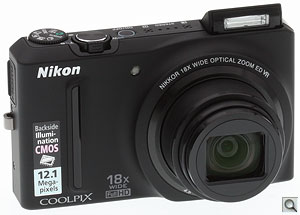 |
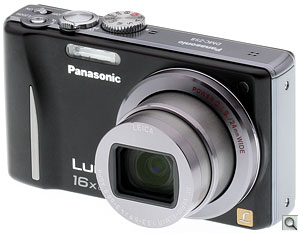 |
|
Nikon Coolpix S9100
We thought the Nikon S9100's slippery bar grip was insufficient, but at least there was something there. The S9100's flash deploys mechanically via a switch on the side. Overall, the Nikon S9100 appealed to us most in use, letting us forget about the camera and concentrate on shooting. Stereo microphones on the top deck flank three holes for a speaker.
|
Panasonic Lumix ZS8
The grip on the Lumix ZS8 supplies a good mechanical ramp for the fingertips to grasp. Note the embedded flash rather than a pop-up design. The Panasonic ZS8 was another camera that was simple enough to let us spend time on composition, forgetting about the camera. Four holes for a monaural mic appear on the top deck.
|
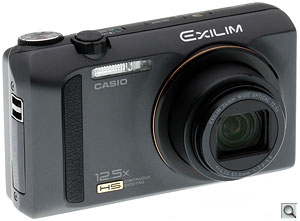 |
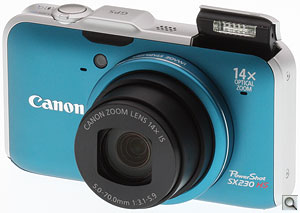 |
|
Casio Exilim ZR100
The Casio's textured grip was good enough, if a little far right to serve as well as it could. The flash is embedded into the front of the ZR-100. Though it appears there's no AF-assist lamp, it's actually part of the flash assembly, represented by the dark patch on the right side. Two holes for the stereo microphone grace the top deck of the ZR-100.
|
Canon PowerShot SX230 HS
Canon provides no grip on the SX230, although the Canon logo on the front includes a texture that does add some sense of traction for your fingers. Rob thought that the rear dial on the Canon SX230 helped make up for the lack of a grip on the front. Annoyingly, the motorized flash pops up whether it's needed or not, but it can be pressed back down with ease. Stereo microphones flank the lens on either side.
|
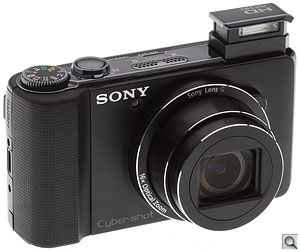 |
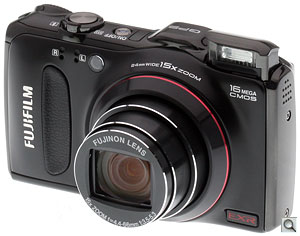 |
|
Sony Cyber-shot HX9V
The Sony HX9V's grip provides the most rubbery feel, making it both warm and comfortable. The HX9V's flash is motorized and pops up when needed, with a unique two-stage telescoping design. Rather prominent stereo microphones rise from the top deck.
|
Fujifilm FinePix F550EXR
The Fujifilm F550EXR delivers a good combination of both mechanical and rubber grip. One minor nuisance is that the flash pops up every time you power the camera on, regardless of the flash mode. Pressing it down retracts it somewhat, but it still doesn't quite seat properly until you power the camera off again. Stereo mics peer out from underneath the zoom toggle.
|
Controls
All six cameras have a mode dial for easy exposure mode selection, and the zoom controls all ring the shutter button. All but the Panasonic ZS8 have power buttons, while the ZS8 has a switch. Four of the six also have complex multi-controllers that employ a wheel as well as four-way rocker mechanisms.
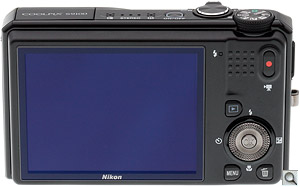 |
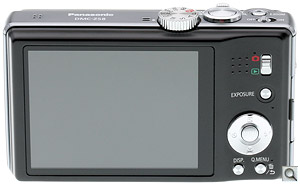 |
|
Nikon Coolpix S9100
All well marked and easy to use, the S9100's controls were liked by our testers, including the wheel on the back. The Mode dial on top is firm enough that it doesn't often turn by accident. The two-stage zoom toggle is quite good, with enough of a slow zone that you don't jump too quickly to high speed zoom, but high speed is right there. One of the better implementations.
|
Panasonic Lumix ZS8
The more primitive interface of the ZS8 was nevertheless simple to use. The Mode dial is firm enough. We didn't like the Record/Playback switch as much, as it prevented them from quickly grabbing a shot while reviewing pictures. Lacking a wheel for the multi-controller wasn't too much of a burden. The ZS8 was the only camera in the group without a dedicated movie button. We liked the E-Zoom option and on-off power switch. Zoom is two-stage, but it's difficult to tell that there's a definite break between the two. Overall good, smooth zooming, though.
|
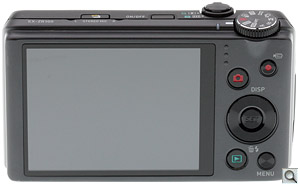 |
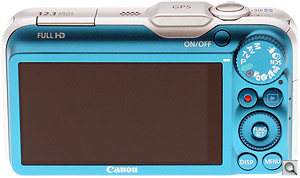 |
|
Casio Exilim ZR100
Also lacking a wheel on the multi-controller (we don't think it's a requirement, just a difference), the Casio ZR100's controls were quite good. Zoom is fast, and more than one button will power on the unit: Both Playback and Record buttons will bring the camera up, and again the Mode dial didn't change accidentally. The zoom is two-stage, but the ZR100 seems to prefer zooming at high speed.
|
Canon PowerShot SX230 HS
Notable for its wider 16:9 aspect screen, the SX230 has a large rear Mode dial, which some liked and others didn't; it's certainly stiff enough, making accidental changes unlikely. The rear dial works well, but the four arrows are unmarked, relying instead on an onscreen virtual map to tell you what the four directions control; press on the disk lightly for the map to appear. Controls are large enough for most hand sizes. The zoom seems quite slow, until you realize that it's a two-stage zoom. But you have to press the lever hard to the left or right to speed it up.
|
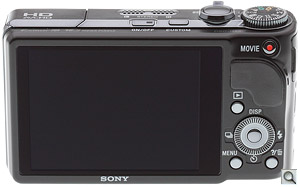 |
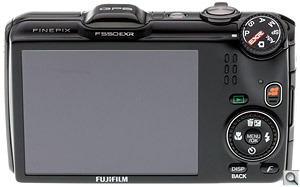 |
|
Sony Cyber-shot HX9V
Though the HX9V's controls were fairly small, we didn't have much trouble with them, and operation was smooth and simple. All except for power-on time. The camera gives you the impression that it's powered on, but it takes an additional five seconds to actually respond to any of your commands (we were able to make it capture a shot at wide-angle in 2.1 seconds in our testing, but that's without any adjustment). That's quite frustrating when the scene is changing in front of you. Otherwise it's quite good, with a stiff mode dial and decent responsiveness. Zoom is single-stage, with pretty smooth operation. The multi-controller includes a wheel on the back.
|
Fujifilm FinePix F550EXR
The Mode dial on the F550EXR is canted for easier viewing from the rear, but it's also unfortunately too easy to turn accidentally. Otherwise, rear controls are well-placed and easy to activate. The two-stage zoom toggle works fairly well, with a very slow and very fast setting. The four-way controller also includes a wheel for fast navigation.
|
Four out of six of our challengers we've already reviewed, and those four were also chosen as Dave's Picks in 2011. But now we've started over and are giving them a fresh look against two other pocket long zooms we've added to the mix. Our contenders are: the Nikon S9100, Panasonic ZS8, Casio ZR100, Canon SX230, Sony HX9V, and Fujifilm F550.

Follow Imaging Resource: